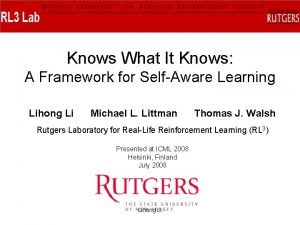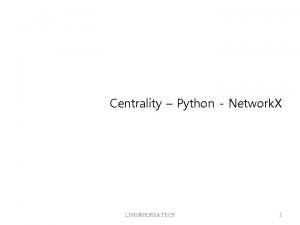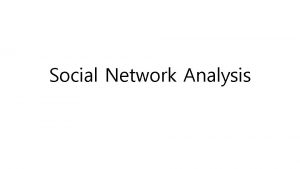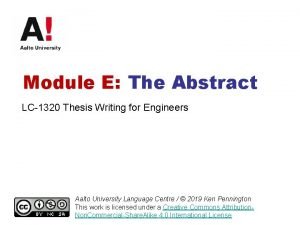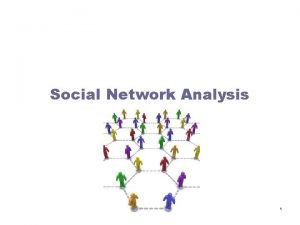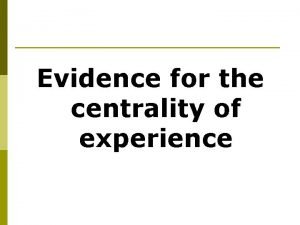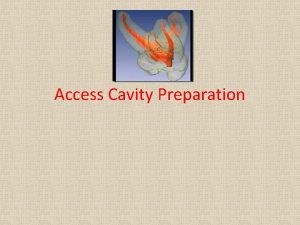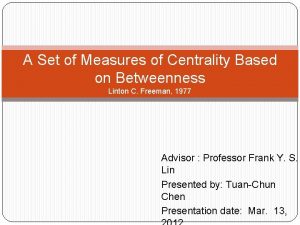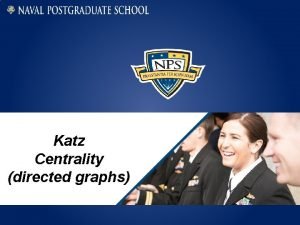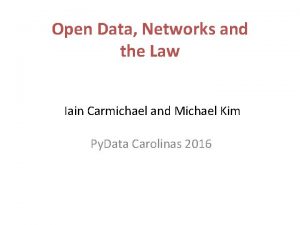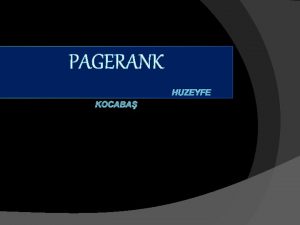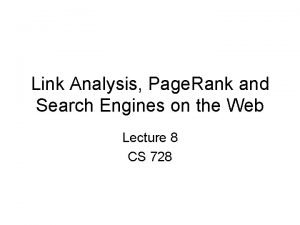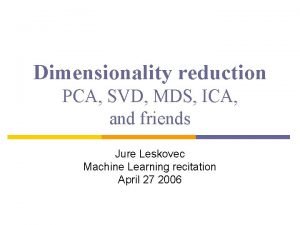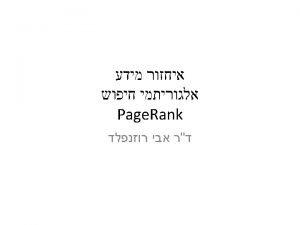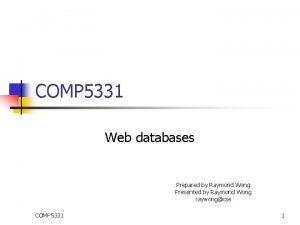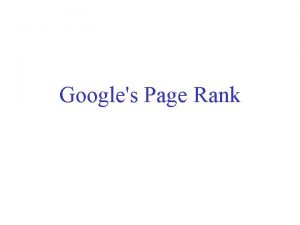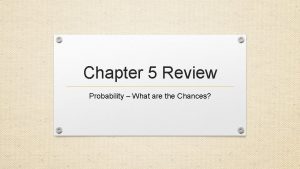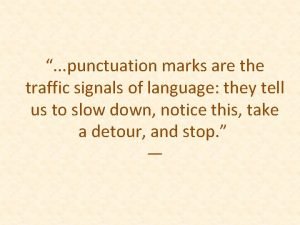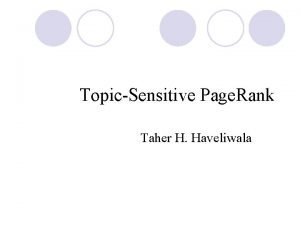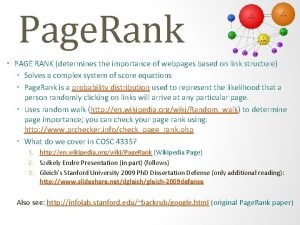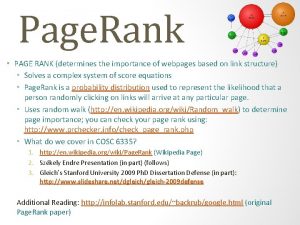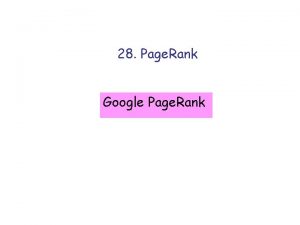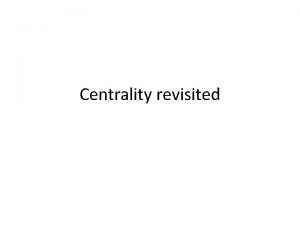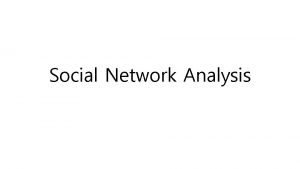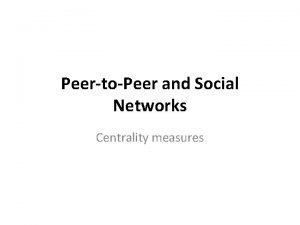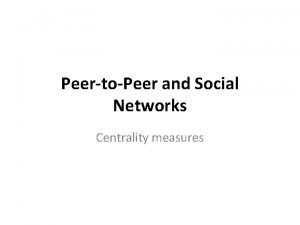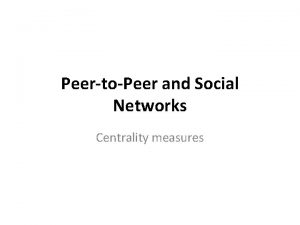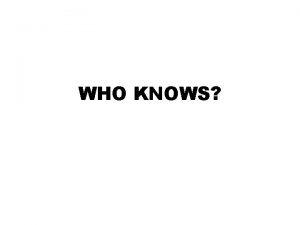Page Rank Centrality Recall Who knows how Page

























- Slides: 25

Page. Rank Centrality

Recall • • Who knows how Page. Rank works? Guesses? In directed graphs: some in-degrees are zero. Fix: Katz centrality used a “free” weight of β New problem: should the weight of the following edges be the same: (11, 9), (5, 11), (3, 8)? • How should we decide on the weight? Think about it while we’re going through the slides. Source: http: //en. wikipedia. org/wiki/Directed_acyclic_graph 2

Introduction –web search • Early search engines mainly compared content similarity of the query and the indexed pages. i. e. , – They use information retrieval methods, cosine similarity, TF-IDF, . . . • In the mid 1990’s, it became clear that content similarity alone was no longer sufficient. – The number of pages grew rapidly in the mid 1990’s. • How to choose only 30 -40 pages and rank them suitably to present to the user? – Content similarity is easily spammed. • Webpage can repeat words and add related words to boost the rankings of his pages and/or to make the pages relevant to a large number of queries. 3

Introduction (cont …) • Starting around 1996, researchers began to work on the problem. They resorted to hyperlinks. – In 1997, Yanhong Li, Scotch Plains, NJ, created a hyperlink based search patent. The method uses words in anchor text of hyperlinks. • Web pages on the other hand are connected through hyperlinks, which carry important information. – Some hyperlinks: organize information at the same site (anchors). – Other hyperlinks: point to pages from other Web sites. Such out-going hyperlinks often indicate an implicit conveyance of authority to the pages being pointed to. • Those pages that are pointed to by many other pages are likely to contain authoritative information. 4

Introduction (cont …) • During 1997 -1998, two most influential hyperlink based search algorithms Page. Rank and HITS were published. • Both algorithms exploit the hyperlinks of the Web to rank pages according to their levels of “prestige” or “authority”. – HITS (Section 7. 5): Prof. Jon Kleinberg (Cornell University), at Ninth Annual ACM-SIAM Symposium on Discrete Algorithms, January 1998. (HITS stands for Hyperlink-Induced Topic Search) – Page. Rank (Section 7. 4): Sergey Brin and Larry Page, Ph. D students from Stanford University, at Seventh International World Wide Web Conference (WWW 7) in April, 1998. • Which one have you heard of? Why? • HITS is part of the Ask search engine (www. Ask. com). • Page. Rank has emerged as the dominant link analysis model – due to its query-independence, – its ability to combat spamming, and – Google’s huge business success. 5

The Page. Rank Algorithm for WWW Sergey Brin and Larry Page in 1998 quitting their Ph. D programs at Stanford to start Google • Invented the Page. Rank Algorithm to rank the returned key word searches • Page. Rank is based on: A webpage is important if it is pointed to by other important pages. • The algorithm was patented in 2001, and refined since.

Page. Rank: the intuitive idea • Page. Rank relies on the democratic nature of the Web by using its vast link structure as an indicator of an individual page's value or quality. • Page. Rank interprets a hyperlink from page i to page j as a vote, by page i, for page j. • However, Page. Rank looks at more than the sheer number of votes; it also analyzes the page that casts the vote. – A vote casted by an “important” page i weighs more heavily and helps to make page j more "important. " (like eigenvector and Katz) – Also, the vote of page i is shared among the pages that it points to, so page j gets a fraction of the vote. • How do we find that fraction? Think about it while we’re going through the slides 7

More specifically • A hyperlink from a page to another page is an implicit transmission of authority to the target page. – • The more in-links that a page i receives, the more prestige the page i has. Pages that point to page i also have their own prestige scores. – – A page of a higher prestige pointing to i is more important than a page of a lower prestige pointing to i. In other words, a page is important if it is pointed to by other important pages. 8

The web can be viewed as directed graph • The nodes or vertices are the web pages. • The edges are the hyperlinks between websites • This digraph has more than 10 billion vertices and it is growing every second! • Google is useful because it ranks these outputs well, not because it find more relevant pages Source: http: //orleansmarketing. com/webdevelopment 1/microsites/#. VMX 4 xnt. HEq. I

The web at a glance Page. Rank Algorithm Forward Index: mapping document to content Mapping content to location Query-independent Source: M. Ram Murty, Queen’s University

Page. Rank algorithm • 11

Matrix notation (1) • 12

Matrix notation (2) • 13

Overview Quality: what makes a node important (central) Mathematical Description Appropriate Usage Lots of one-hop connections to high centrality vertices A weighted degree centrality based on the weight of the neighbors For example when the people you are connected to matter. Lots of one-hop connections to high out-degree vertices A weighted degree centrality based on the out degree of the neighbors Directed graphs that are not strongly connected As above but distribute the weight that a node has to the nodes it points to Identification As above but distributing the wealth of a node to the ones it points to PR: most known and influential algorithms for computing the relevance of web pages

An example as just described: Problem vertex (no outgoing links) in-degree matrix Is the formula above well defined? each row shows the in degree If not, how could we fix the formula or the matrix? each column shows the out degree

How can we fix the problem? 1. 2. Remove those pages with no out-links during the Page. Rank computation as these pages do not affect the ranking of any other page directly (these pages will get outgoing links in the future). Add a complete set of outgoing links from each such page i to all the pages on the Web. in-degree matrix The second choice is used in PR since matrix may get updated each column shows the out degree each row shows the in degree 16

How can we fix the out degree = 0? in-degree matrix Inverse of the out-degree matrix 17

PR centrality formula is well defined By multiplying them we obtain the matrix that captures: 1. 2. The in and out degree per vertex Divides the centrality of each vertex by its degree The contribution of node 5 is insignificant, and the formula is now well defined out-degree matrix in-degree matrix 18

Transition probability matrix • 19

A 4 -website Internet Source: http: //www. math. cornell. edu/~mec/Winter 2009/Raluca. Remus/Lecture 3/lecture 3. html 20

A 4 -website Internet pij represents the transition probability that the surfer on page j will move to page i: Source: http: //www. math. cornell. edu/~mec/Winter 2009/Raluca. Remus/Lecture 3/lecture 3. html 21

A 4 -website Internet Random surfer: each page has equal probability ¼ to be chosen as a starting point. Simplification for this example: No β was involved since id i > 0, for all i Source: http: //www. math. cornell. edu/~mec/Winter 2009/Raluca. Remus/Lecture 3/lecture 3. html 22

Overview Updated! Quality: what makes a node important (central) Mathematical Description Appropriate Usage Lots of one-hop connections to high centrality vertices A weighted degree centrality based on the weight of the neighbors For example when the people you are connected to matter. Lots of one-hop connections to high outdegree vertices A weighted Directed graphs degree centrality that are not based on the out strongly connected degree of the neighbors As above but distribute the weight that a node has to the nodes it points to As above but distributing the wealth of a node to the ones it points to Identification

Some comments •

Final Points on Page. Rank • Fighting spam. – A page is important if the pages pointing to it are important. – Since it is not easy for Web page owner to add in-links into his/her page from other important pages, it is thus not easy to influence Page. Rank. • Page. Rank is a global measure and is query independent. – The values of the Page. Rank algorithm of all the pages are computed and saved off-line rather than at the query time => fast • Criticism: – There are companies that can increase your Page. Rank by adding it to a cluster and increasing its indegree – It cannot distinguish between pages that are authoritative in general and pages that are authoritative on the query topic. • But it works based on the keyword search 25
 Page rank centrality
Page rank centrality Knows what it knows: a framework for self-aware learning
Knows what it knows: a framework for self-aware learning Degree centrality python
Degree centrality python Degree centrality python
Degree centrality python Abstract example
Abstract example Brain gain definition ap human geography
Brain gain definition ap human geography Normalized degree centrality example
Normalized degree centrality example Centrality of experience
Centrality of experience Access opening definition
Access opening definition A set of measures of centrality based on betweenness
A set of measures of centrality based on betweenness Katz centrality networkx
Katz centrality networkx Closeness centrality
Closeness centrality Google page rank algorithm
Google page rank algorithm Pagerank nedir
Pagerank nedir Page rank
Page rank Pagerank random walk
Pagerank random walk Topic specific pagerank
Topic specific pagerank Google page rank algorithm
Google page rank algorithm Page rank viewer
Page rank viewer Checkpagerank.net
Checkpagerank.net Google page rank algorithm
Google page rank algorithm Google page rank
Google page rank Title in apa format
Title in apa format A popular airline knows that in general 95
A popular airline knows that in general 95 Punctuation marks are like traffic signs. this sentence is
Punctuation marks are like traffic signs. this sentence is Father knows least
Father knows least

